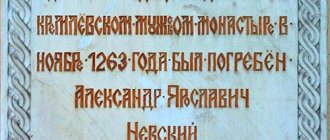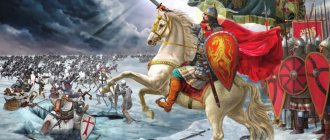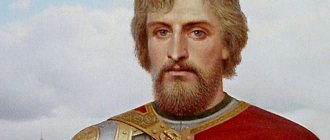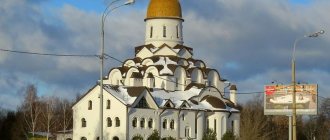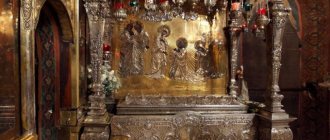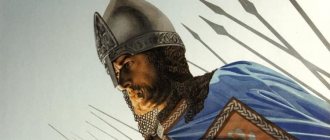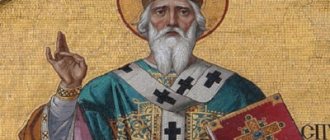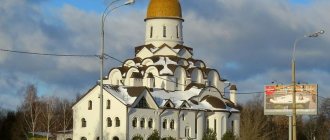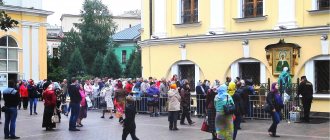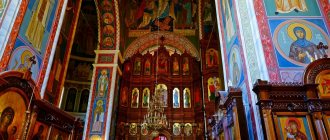Immediately after his death, Alexander Nevsky was buried in Vladimir. Until the 16th century, it was the Nativity Monastery that remained the first in Rus' and was called the “Great Archimandrite.” The remains of the Grand Duke remained buried until 1380.
It was this year that the local sexton had a prophetic dream, after which the coffin with the incorruptible relics was lifted from the grave and placed on top of the ground. Today, the relics of Saint Prince Alexander Nevsky are kept in the Alexander Nevsky Lavra of the Northern capital. The last shrine they were in is located in the St. Petersburg Hermitage. The history of the relics is eventful.
Sources
Alexander Nevsky was canonized by the church in 1547. At that time, the prince was already revered by the people as a saint. The fact that the relics of the saint were in the open is also evidenced by numerous testimonies of healings of the sick, possessed and blind people.
Important! For the first time the prince was named a saint in the chronicles for 1377. The following was written about the discovery of the relics for parishioners and monks: “The great bishop... the great autocrat, having excavated the place, went to the many healing all-holy relics of the saint laid in everyday life, having found them incorruptible and intact from many years... you will place it in the race at the top of the earth in the Church of the Most Pure Mother of God, in it but it must have happened first.”
Scientists received information about further events from the lists of the Resurrection and Nikon Chronicles of the 16th century that have survived to this day. According to ancient records, in 1491 there was a big fire in Vladimir and the prince’s body was burned. However, later versions of these chronicles, dating back to the 17th century, contain a completely changed story about the divine rescue of the prince’s relics from the fire. People also had a vision in which the prince rose on his horse into the heavens.
Other written sources
Before the lists of chronicles, there were other written sources with stories about the incorruptible relics of the prince. But they do not contain descriptions of the heavenly vision of the horseman Alexander. In particular, the Front Chronicle of the 16th century testifies to the preservation of the relics and the shroud that covered them from fire. It also contains a story about the miraculous recovery of a member of the royal retinue, Athanasius.
The man was one of the retinue of Tsar Ivan the Terrible during the Kazan campaign of 1552. During the royal prayer service to the holy prince Athanasius, he put his sore hand into the hole of the coffin and immediately received healing. A similar narrative with a heavenly vision is contained in the 18th century version of the Book of Degrees.
Interesting! In 1695, a specially made reliquary of very fine workmanship in a silver setting with gilding was brought from Moscow. Two years later, the relics were placed there by Metropolitan Hilarion of Suzdal.
Before Peter I came to power, the relics of the saint beloved by the people remained in Vladimir. In the city where Alexander Nevsky was buried, he was revered long before his canonization. People loved their prince, but a new round of history brought changes. With the beginning of the construction of St. Petersburg, Peter had the idea of transferring the relics to the new Alexander Nevsky Lavra.
Thus, the king wanted to make the great warrior and diplomat the heavenly patron of the city. In Russia, many icons with the face of Alexander Nevsky were painted earlier. The prince was often depicted on triumphal monuments in honor of the victories of Russian soldiers. Very soon Peter I brought his idea to life. It was decided to transport the relics of one of the most beloved and revered saints to the new city of St. Petersburg.
Interesting facts about the Alexander Nevsky Lavra
Between the Lavra and the Neva there is the famous graffiti of Sergei Bodrov the Younger. Amazingly drawn.
Peter I initially conceived the Lavra as a new type of monasticism, it was supposed to help people for free, so there were medical buildings for the sick, there were educational buildings where one could study, and there was a fortress wall around it to protect the southern approach to the city.
The park is open 24 hours a day, and I really like to walk here in the evenings - it’s one of the few quiet places in the city center.
First transfer of relics
Peter announced his order while in the Alexander Nevsky Lavra.
The ambitious sovereign “commanded that the relics of Alexander Nevsky located in the Vladimir Nativity Monastery be transferred here.” A complex ritual of moving the shrine to St. Petersburg was immediately thought out. The event was given special significance. A convenient ark was made to carry the relics. The process itself began on August 11, 1724. On this day, special services were performed in all churches. However, it was not without difficulties. They could not immediately take the ark out of the monastery. It turned out to be wider than the gate, so the wall was dismantled. But the difficulties did not end there. The procession overcame an unexpectedly collapsed crossing on the Vorsha River.
From Novgorod the casket traveled to St. Petersburg by water. Peter I followed the galley towards him and personally transferred the relics from the yacht to his ship. Near the shore, the royal galley was greeted with solemn cannon and weapon salvoes. On August 30, 1724, the Tsar himself transferred the ark with the shrine to the Alexander Nevsky Monastery. The shrine was symbolically laid at the foundation of the city of Petra.
What did Alexander Nevsky look like?
Despite the popularity of Alexander Nevsky in Russia, there are no lifetime images of this man. However, until the era of Ivan the Terrible, it was generally not customary to draw portraits of rulers from the Rurik family during their lifetime. If you look at the portraits of the prince in chronicle sources and the images on the icons, you can see that they are all significantly different from each other. Here is what is said about the appearance of Alexander Yaroslavich in the chronicle “The Life of Alexander Nevsky”: “Also, the honor of the earthly kingdom comes from God, and the spouse of the name and child of life, but the humble wisdom of the acquis like all people, no matter how old you are, great, beautiful “You will see his face like Joseph the Beautiful, but his strength is part of the strength of Samson, and his voice will be heard like a trumpet among the people.” V.V. Dolgov, in his article “Alexander Nevsky,” published in 2015 in the journal “Questions of History,” reports: “This is how the iconographic “originals” (verbal instructions for icon painters) of the 16th-17th centuries describe the appearance of the prince: “brada like Kozmina, in schema , the Kuderians can see a little from under the schema, the priest’s robe is smoky from underneath, a scroll is clenched in his hand, his body is shouldered.” When the Order of Alexander Nevsky was established in 1942, the actor Nikolai Cherkasov, who played the leading role in the film “Alexander Nevsky,” was depicted on it. You can ask a reasonable question: why not try to restore Nevsky’s appearance using the relics, say, according to the method of the famous scientist M.M. Gerasimova? But how to do this if there are doubts about the identity of the remains? It is curious that the image of Alexander Nevsky on the veil (posthumous veil), dating back to the beginning of the 17th century, differs significantly from the generally accepted options that usually depict us as a real Russian rich rya. Thus, oriental features are visible in the prince’s appearance. However, this is not surprising, because Alexander’s mother, Princess Feodosia, was a Polovtsian princess. The Rurikovichs often took Polovtsian women as wives. So the mysteries remain...
Celebrating a great event
The discovery of the relics of one of the people's most beloved saints was celebrated for three days in a row. The St. Petersburg events were duly immortalized:
- The Emperor commanded all churches to set August 30 (September 12, New Style) as the day for the transfer of the relics.
- The holiday was timed to coincide with the day of the victory of the Russian army in the Northern War, which lasted 21 years.
- Peter dreamed of establishing the order of the saint, but did not have time to realize the idea. Later, this was done by the sovereign’s wife, Catherine I.
In 1790, the holy remains of the blessed prince were placed in the Trinity Cathedral. Empress Elizaveta Petrovna donated a silver shrine for them to the monastery back in 1753. The casket is made of 90 pounds of silver. In the new cathedral, completed in 1790, the relics are placed near the right choir.
Soviet period
After the revolution of 1917, the most terrible period began for the Orthodox faith and all its shrines. In 1922, the monastery was going through difficult times. The Trinity Cathedral was closed, and the shrine containing the relics of Alexander Nevsky was barbarically opened. Inside, vandals found 12 small bones of different shades. Such a find meant that the casket contained the remains of different people. Two fragments of one right leg turned out to be identical. The Bolsheviks confiscated the cancer and transferred it to the Hermitage for storage, where it remains today.
The unidentified remains were then sent to the museum storerooms at the Kazan Cathedral. However, the relics were not forgotten, since the Soviet authorities seriously needed them for their own propaganda. In 1938, the film “Alexander Nevsky” was released. For their undisputed masterpiece, the director and screenwriter were awarded the Stalin Prize. The “leader of the peoples” himself proclaimed the ancient Russian prince one of the heroes of Russian history.
The events took place in July 1941, when it was necessary to unite the entire people in the fight against the Nazi invaders. The subsequently established Military Order of Alexander Nevsky was awarded to 42 thousand military commanders during the war. In 1943, the Bolsheviks hastened to open the Trinity Cathedral and design it as a place for prayers to the heavenly patron of Russian soldiers. The relics returned to the cathedral much later - in 1989.
A particle of the princely relics from Vladimir (relics from a shrine) ended up in the Trinity Church. In 1923, it was placed in the Assumption Cathedral, where it is still kept. At the same time, the authenticity of the remains has not been confirmed by experts.
After the decree of Patriarch Alexy II in 1998, a small part of the princely relics was transferred to Bulgaria. In the saint’s homeland in Vladimir, the saint’s little finger is kept. There is a special icon with a reliquary of Alexander Nevsky in the Ural village of Shurala.
Unique sarcophagus
The saint's shrine is a unique work of art, which the Bolsheviks considered it a good idea to appropriate for themselves. Since then, negotiations have been underway to transfer the unique shrine back to the Church. For now, the sarcophagus is kept in the Hermitage. The entire composition consists of several parts:
- Two arks - the small one was created in the Baroque style. It is covered with an icon where the saint appears in monastic vestments. The large shrine was made during the reign of Elizabeth by the best craftsmen. 1.5 tons of silver were spent on production. The decorations were remade because many of them were not the right size.
- Pyramid - consists of tiers that create the appearance of an asymmetrical building with no straight lines.
- Two candlesticks and pedestals complete the masters' design.
The unique structure was handed over for restoration, but so far the decision to transfer the shrine back to the Church has not been made.
conclusions
The history of the movement of the holy remains of Alexander Nevsky goes back 800 years. During this time, the casket with precious remains was transported many times, that is, the shrine from Elizaveta Petrovna was already the third refuge of the Grand Duke. After 1790, the relics remained inviolable and revered by the residents of St. Petersburg. However, in 1917, the period of peace was interrupted by the Bolshevik invasion of the territory of the Lavra Holy Trinity Cathedral. The Metropolitan became seriously concerned about the fate of the Orthodox shrine and instructed the clergy to check the contents of the shrine. When the casket was opened hundreds of years later, it revealed a wax doll made in the shape of a human body.
The dummy itself contained fragments of the remains, the remaining parts lay separately. Thus, there was a replacement of the relics in the period from 1724 to 1917. None of the clergy of the Lavra most likely knew about this. But the servants of the Lavra could well have suffered at the hands of the Bolsheviks. That is why the relics were hastily moved to a wooden casket, which became the fourth tomb of Alexander Nevsky. In 1922, this casket was opened by atheists in order to accuse the clergy of deceiving the people; the doll was already liquidated.
Today, skeptical historians suggest that the princely relics are lost forever. 800 years after burial, they are becoming increasingly difficult to find. However, the development of science and technology makes it possible to study the remains more effectively, which means the search continues. Genetic analysis capabilities make it possible to identify more remains than previously.
List of used literature:
- The first chronicle of Novgorod, older and younger editions.
- A.P. Bogdanov "Alexander Nevsky"
Necropolis of Art Masters
Initially, it was the Tikhvin cemetery, where famous cultural figures were buried. At one time it contained 1,300 graves.
But after the revolution, the cemetery fell into disrepair and in Soviet times they decided to turn it into a necropolis. All the old graves were demolished, and famous people of the Soviet era were reburied in their place.
This is a real museum. The headstones here don't look like graves at all. Since most of them were made in Soviet times, they are without crosses.
Here are monuments to famous writers, poets, composers, sculptors, artists, such as P. Vyazemsky, A. Glazunov, M. Glinka, N. Gnedich, I. Gorbunov, F. Dostoevsky, A. Borodin, M. Mussorgsky, N. Rimsky-Korsakov, P. Tchaikovsky, I. Kramsky, B. Kustodiev, I. Shishkin, I. Dmitrevsky, P. Karatygin, and other representatives of Russian culture and art of the 19th-20th centuries.
At the entrance you can take a free map with the graves of the most famous people
There is a sculpture museum on site. It is included in the ticket price. There is a coffee machine and a free toilet inside.
All the monuments of St. Petersburg are also presented here in miniature.
Only here you can examine all the monuments in detail
Behind many monuments there are historical photographs of how they were created
